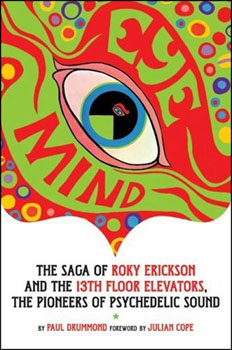From San Francisco to London, the youth of the 1960s were turning on, tuning in and dropping out like flies on a mudslide. A cultural upheaval set the establishment on its collective ear, announcing loud and clear that a new generation was on the rise and about to change the world. As with any sociological shift came a slew of casualties — burnouts on the corner of Haight and Ashbury, the heart of Piccadilly, and hundreds of lofts and crash pads from New York to Los Angeles — jam packed with a gaggle of esteemed trend setters, socialites and rock stars — Edie Sedgwick, Tara Browne, Jimi Hendrix, Janis Joplin, among the ever after.
Time, Newsweek and the major networks had their eyes fixed on the metropolitan miscreants, but a psychedelic scene of its own was festering deep in the heart of Texas. A wayward group of musically gifted, chemically enhanced hooligans called the 13th Floor Elevators were making noise in Austin, notorious for their LSD-fueled performances. Unbeknownst to many is a tale of lunacy and misfortune that marred the Elevators’ chance at widespread appeal. Their story gets a thorough examination by Paul Drummond in Eye Mind: The Saga Of Rory Erickson And The 13th Floor Elevators, The Pioneers Of Psychedelic Sound, a recently released biography from Process Media.
Drummond obviously did his homework as he digs into the psyche of the Elevators, dissecting each piece of the puzzle that comprises the group’s scarred membership, with much of the attention lauded on the core trio of Roky Erickson, Tommy Hall and Stacy Sutherland. Erickson’s story is a dominant, ongoing thread — a coddled and confused young man, with a natural aptitude for music and an impressionable attitude. The charismatic Erickson was arguably the only Elevator with any real musical promise, yet his sanity and bouts with the authorities grabbed the headlines. As the book reveals, Erickson would soon overcome his demons, get the proper medical help he needed, and return to the mainstream as a performer and functioning member of society.
Tommy Hall is credited as the leader and driving force behind the 13th Floor Elevators. With no musical training whatsoever, Hall blew into a jug and somehow incorporated its pulsating, almost desperate discharge into the fabric of the Elevators’ sound. He stood out as a highly intelligent, well-read, somewhat conservative iconoclast of the first order whose appetite for LSD was fast and furious. Acid, he claimed, enabled him to tap deeper into any number of subjects and ideologies — philosophy, religion, history, astrology, science — as sources of inspiration for his lyrics. Now living as a hermit tucked away among the row houses of San Francisco, Hall came close to realizing his vision as an LSD guru, but he lacked the ability to roll with the changes to push his cause forward. For all of his contributions to the psychedelic movement, Hall may be forever immortalized as the only guy ever to get away with blowing a jug in a rock and roll band.
Stacy Sutherland was the resolute guitarist whose misfortunes led to an early demise. His legal problems and loose affiliations prevented the Elevators from touring beyond the Texas border (after their infamous trips to San Francisco). Although he singlehandedly gave the band their edge, drugs and alcohol plagued Sutherland his whole life, along with near-poverty living conditions (something all of the 13th Floor Elevators dealt with) and a wife who accidentally stabbed him to death in 1978.
Other Elevators naturally fit into the picture. Drummer John Ike seems to have emerged from the experience relatively unscathed (and supposedly retains the rights to the 13th Floor Elevators moniker). He and bassist Ronnie Leatherman left the Elevators after the first album out of frustration for something to happen. Original Elevators bassist Benny Thurman, lyricist (and Tommy Hall’s paramour) Clementine Hall, luminaries like Powell St. John, Billy Gibbons and Chet Helms, along with several associates and family members, all tell their side of the story. The exhaustive research and unlimited access to virtually everyone involved certainly adds an unusually strong element of validity to the book and its account of the 13th Floor Elevators. When you consider the pitfalls and general malaise that any band goes through, it’s almost a given that an unwieldy tale like this practically writes itself.
Most of the rock bios I’ve read have been about those who’ve made the grade — the Beatles, the Stones, Zeppelin, the Who, Bob Dylan, Neil Young, etc. After reading Eye Mind, I started thinking about the hundreds of bands, singers, songwriters and musicians that came close, but never crossed the finish line. The drama rarely gets this intense. The 13th Floor Elevators story, like few before or since, is a mine field of tragedy and deceit — far from the typical rock and roll tomb. And it makes for a fascinating read.
Like Syd Barrett and Brian Wilson, Roky Erickson’s drug experiences took him away from his music. Fortunately, like Wilson, he’s been able to emerge from a history of haziness and is actively making music again. Books like Eye Mind: The Saga Of Roky Erickson And The 13th Floor Elevators, The Pioneers Of Psychedelic Sound help shed light on Erickson and a legacy that deserves reassessment — and a ton of respect.
~ Shawn Perry




















